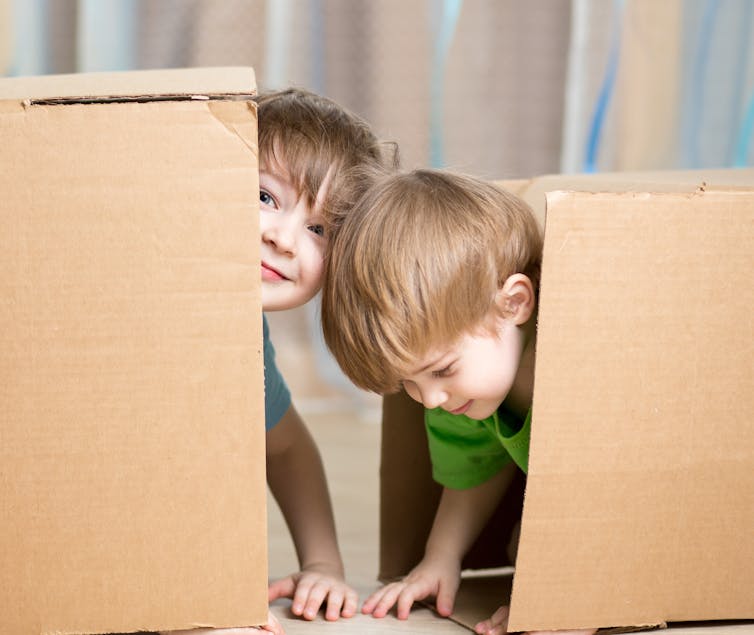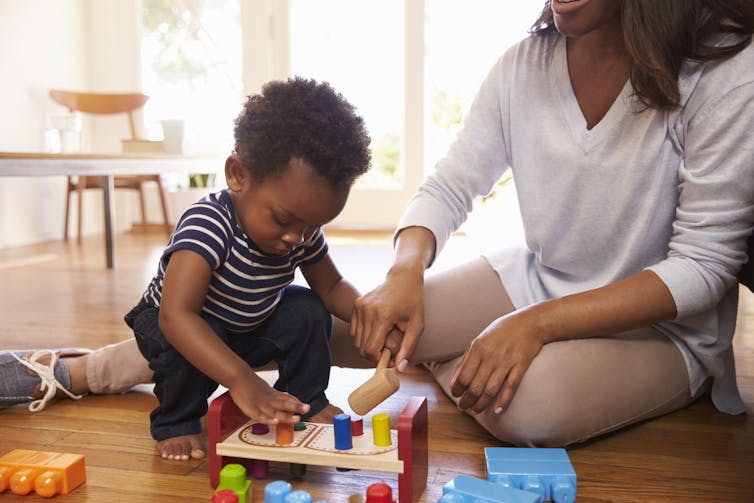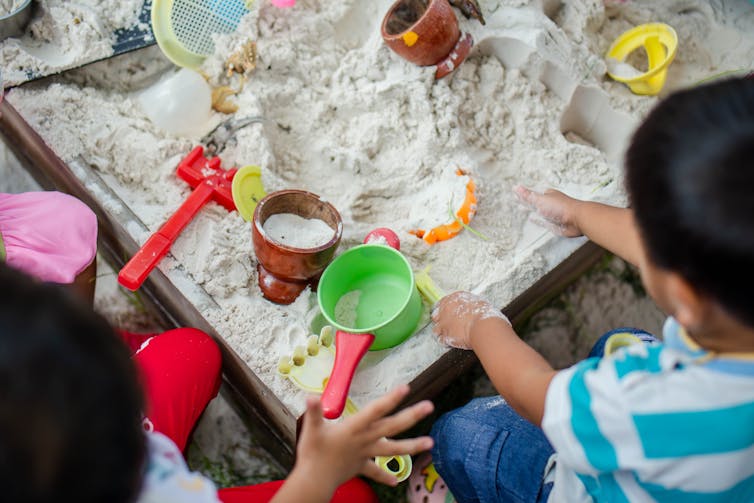
Ozlem Cankaya, MacEwan University
Many have observed that sometimes when given a toy as a present, children play with the box the toy came in, or even the gift wrapping.
In earlier generations, children’s play materials were often homemade or relatively simple. Commercial or hand-made toys were made from durable and long-lasting materials.
Today, mass-produced plastic toys with limited purpose have permanently entered children’s learning environments. These toys are often designed to be used in specific ways, with limited imaginative play opportunities.
A trend in the marketing of sustainable toys coincides both with addressing ecological concerns, and with educational interest in play materials that allow children to play in many ways.
A type of play known by researchers and educators as “loose parts play” involves children playing with and re-purposing materials that can be used in multiple ways. This can include playing with everyday, natural or manufactured parts (like cardboard, sticks, pots and pans, sand or beads not originally intended for play) or with commercial toys like blocks or stackable cups.
The language of loose parts to talk about the use of unrestricted items in children’s play was first used by architect Simon Nicholson in the 70s, who discussed a “theory of loose parts” when writing about playground and educational design.
My research with colleagues is examining which materials — including store-bought and natural or upcycled items — are most conducive to specific types of quality play in young children’s environments.

What is play?
Play is often defined as an activity pursued for its own sake and characterized largely by its processes rather than end goals. Although the exact definition of play is debated, researchers agree it is exceptionally complex.
Play has also been described as an integrating process, providing an ecosystem where children can make connections between previous experiences, represent their ideas in different ways, imagine possibilities, explore and create new meanings.
Such complexity can be seen in children’s play themes, materials, content, social interactions, and the understandings children demonstrate in their play.
The more complex the play, the more it impacts development. Even a small dose of quality play improves children’s performance on subsequent cognitive development tasks.
Complex play, skills and benefits
The skills acquired in play — including overcoming impulses, behaviour control, exploration and discovery, problem-solving, social interaction, and attention to process and outcomes — are foundational cognitive structures that also drive learning.
Children’s play themes generally follow the ideas inherent in the materials and toys available.
However, as noted, materials and toys used for children’s play have changed significantly over the years, reflecting societal changes, technological advancements and shifts in understanding child development.
Early learning and child-care communities today widely incorporate loose parts for their perceived potential to offer high-quality play opportunities. Such opportunities allow children to use their imaginations and explore their surroundings and support children’s cognitive development.
Education in Canada
In Canada, Alberta, Manitoba and Nova Scotia’s education guidelines for early childhood explicitly discuss the importance of loose parts play. The Nova Scotia Curriculum, for instance, acknowledges that the use of loose parts encourages “creativity and open-ended learning.”
Six other provincial frameworks don’t use the words “loose parts,” but equally stress the importance of this kind of play. While many parents, educators and policy-makers recognize the benefits of involving children in play with loose parts, the basic evidence regarding children’s indoor play with loose materials is unknown.
There are only a handful of empirical studies on indoor loose parts play with limited focus on its developmental benefits beyond children’s physical and social development. Research has narrowly focused on children’s outdoor play with loose parts and mostly on physical and social development.

Current research has not examined children’s indoor play with loose parts and its relationship to children’s cognitive skills. As a result, educators and policy-makers have little empirical evidence on which to base important decisions about what materials to invest in and integrate into children’s learning environments.
Equitable play opportunities
Children from socio-economically disadvantaged backgrounds start kindergarten disproportionately behind their more affluent and privileged peers in knowledge and educational performance.
Low-income families often cannot afford toys for children. Could household objects (like plastic tubs or egg cartons) offer equitable play opportunities for all children, if early childhood programs and professionals supported parents with up-cycling items into play things?
My colleagues and I are conducting research to address gaps in our understanding of children’s loose parts play. Specifically, we examine the play types and play engagement levels of children between the ages of four and five who participate in our study.
We also take into account the effects of children’s cognitive development, parental income and education on how young children play with everyday objects, both when they play by themselves and with their parents.
We just finished collecting data in the first phase of our studies focused on children’s solitary play. Children were given opportunities to play with either a box of carefully curated loose parts like blocks, felt balls, yarn, pinecones or a toy that had only a limited function: percussion instruments.
Cognitive and language development
We collected data using video recordings of children’s play in two sessions (one with loose parts and the other session with the limited-purpose toy as a control), parent questionnaires and a cognitive measurement tool for benchmarking children’s cognitive and language development.
We are now analyzing crucial relationships between children’s play with different loose objects and children’s cognitive development, and considering key social determinants such as gender, socioeconomic status and maternal education.
Such knowledge will support educators and parents with an understanding of which materials are most conducive to specific types of quality play in young children’s environments.![]()
Ozlem Cankaya, Assistant Professor, Early Childhood Curriculum Studies, MacEwan University
This article is republished from The Conversation under a Creative Commons license. Read the original article.

